Effects of Naphthalene Application on Soil Fungal Community Structure in a Poplar Plantation in Northern Jiangsu, China
Abstract
1. Introduction
2. Materials and Methods
2.1. Site Description and Experimental Design
2.2. Chemical Analysis and Soil Arthropod Extraction
2.3. Extraction of Fungal Genome
2.4. Illumina MiSeq Sequencing and Processing
2.5. Data Analysis
3. Results
3.1. Soil Fauna Abundance and Litter Mass Remaining
3.2. Soil Fungal Community Diversity
3.3. Soil Fungal Community Composition
4. Discussion
4.1. Naphthalene’s Effects on Soil Fungal Communities and Litter Decomposition
4.2. Limitations and Future Work
5. Conclusions
Author Contributions
Funding
Data Availability Statement
Acknowledgments
Conflicts of Interest
References
- Wardle, D.A.; Bardgett, R.D.; Klironomos, J.N.; Setala, H.; van der Putten, W.H.; Wall, D.H. Ecological linkages between aboveground and belowground biota. Science 2004, 304, 1629–1633. [Google Scholar] [CrossRef] [PubMed]
- Bardgett, R.D.; van der Putten, W.H. Belowground biodiversity and ecosystem functioning. Nature 2014, 515, 505–511. [Google Scholar] [CrossRef] [PubMed]
- Gea, A.B.d.; Hautier, Y.; Geisen, S. Interactive effects of global change drivers as determinants of the link between soil biodiversity and ecosystem functioning. Glob. Chang. Biol. 2023, 29, 296–307. [Google Scholar] [CrossRef]
- Frouz, J. Effects of soil macro- and mesofauna on litter decomposition and soil organic matter stabilization. Geoderma 2018, 332, 161–172. [Google Scholar] [CrossRef]
- Crowther, T.W.; van den Hoogen, J.; Wan, J.; Mayes, M.A.; Keiser, A.D.; Mo, L.; Averill, C.; Maynard, D.S. The global soil community and its influence on biogeochemistry. Science 2019, 365, eaav0550. [Google Scholar] [CrossRef] [PubMed]
- Hannula, S.E.; Morrien, E. Will fungi solve the carbon dilemma? Geoderma 2022, 413, 115767. [Google Scholar] [CrossRef]
- Ball, B.A.; Bradford, M.A.; Coleman, D.C.; Hunter, M.D. Linkages between below and aboveground communities: Decomposer responses to simulated tree species loss are largely additive. Soil Biol. Biochem. 2009, 41, 1155–1163. [Google Scholar] [CrossRef]
- Yin, R.; Qin, W.; Wang, X.; Xie, D.; Wang, H.; Zhao, H.; Zhang, Z.; He, J.-S.; Schadler, M.; Kardol, P.; et al. Experimental warming causes mismatches in alpine plant-microbe-fauna phenology. Nat. Commun. 2023, 14, 2159. [Google Scholar] [CrossRef]
- Peng, Y.; Vesterdal, L.; Penuelas, J.; Peguero, G.; Wu, Q.; Hedenec, P.; Yue, K.; Wu, F. Soil fauna effects on litter decomposition are better predicted by fauna communities within litterbags than by ambient soil fauna communities. Plant Soil 2023. [Google Scholar] [CrossRef]
- David, J.F. The role of litter-feeding macroarthropods in decomposition processes: A reappraisal of common views. Soil Biol. Biochem. 2014, 76, 109–118. [Google Scholar] [CrossRef]
- Griffiths, H.M.; Ashton, L.A.; Parr, C.L.; Eggleton, P. The impact of invertebrate decomposers on plants and soil. New Phytol. 2021, 231, 2142–2149. [Google Scholar] [CrossRef] [PubMed]
- Heneghan, L.; Coleman, D.C.; Zou, X.; Crossley, D.A.; Haines, B.L. Soil microarthropod community structure and litter decomposition dynamics: A study of tropical and temperate sites. Appl. Soil Ecol. 1998, 9, 33–38. [Google Scholar] [CrossRef]
- Hou, P.C.L.; Zou, X.M.; Huang, C.Y.; Chien, H.J. Plant litter decomposition influenced by soil animals and disturbance in a subtropical rainforest of Taiwan. Pedobiologia 2005, 49, 539–547. [Google Scholar] [CrossRef]
- Araujo, P.I.; Yahdjian, L.; Austin, A.T. Do soil organisms affect aboveground litter decomposition in the semiarid Patagonian steppe, Argentina? Oecologia 2012, 168, 221–230. [Google Scholar] [CrossRef]
- Hu, D.; Wang, M.; Zheng, Y.; Lv, M.; Zhu, G.; Zhong, Q.; Cheng, D. Leaf litter phosphorus regulates the soil meso- and micro-faunal contribution to home-field advantage effects on litter decomposition along elevation gradients. Catena 2021, 207, 105673. [Google Scholar] [CrossRef]
- Liu, J.; You, C.; Xu, Z.; Liu, Y.; Zhang, L.; Li, H.; Wang, L.; Liu, S.; He, S.; Luo, Z.; et al. Soil arthropods promote litter enzyme activity by regulating microbial carbon limitation and ecoenzymatic stoichiometry in a subalpine forest. Sci. Total Environ. 2023, 876, 162789. [Google Scholar] [CrossRef]
- Gonzalez, G.; Seastedt, T.R. Soil fauna and plant litter decomposition in tropical and subalpine forests. Ecology 2001, 82, 955–964. [Google Scholar] [CrossRef]
- Wall, D.H.; Bradford, M.A.; St. John, M.G.; Trofymow, J.A.; Behan-Pelletier, V.; Bignell, D.D.E.; Dangerfield, J.M.; Parton, W.J.; Rusek, J.; Voigt, W.; et al. Global decomposition experiment shows soil animal impacts on decomposition are climate-dependent. Glob. Chang. Biol. 2008, 14, 2661–2677. [Google Scholar] [CrossRef]
- Xiong, Y.; Shao, Y.; Xia, H.; Li, Z.; Fu, S. Selection of selective biocides on soil microarthropods. Soil Biol. Biochem. 2008, 40, 2706–2709. [Google Scholar] [CrossRef]
- Cotrufo, M.F.; Soong, J.; Vandegehuchte, M.L.; Nguyen, T.; Denef, K.; Shaw, E.A.; Sylvain, Z.A.; de Tomasel, C.M.; Nielsen, U.N.; Wall, D.H. Naphthalene addition to soil. surfaces: A feasible method to reduce soil micro-arthropods with negligible direct effects on soil C dynamics. Appl. Soil Ecol. 2014, 74, 21–29. [Google Scholar] [CrossRef]
- Seastedt, T.R.; Crossley, D.A. Effects of microarthropods on the seasonal dynamics of nutrients in forest litter. Soil Biol. Biochem. 1980, 12, 337–342. [Google Scholar] [CrossRef]
- Lan, L.; Yang, F.; Zhang, L.; Yang, W.; Wu, F.; Xu, Z.; Liu, Y.; Yue, K.; Ni, X.; Li, H.; et al. Non-target Effects of Naphthalene on the Soil Microbial Biomass and Bacterial Communities in the Subalpine Forests of Western China. Sci. Rep. 2019, 9, 9811. [Google Scholar] [CrossRef] [PubMed]
- Liu, Y.; Yang, F.; Yang, W.; Wu, F.; Xu, Z.; Liu, Y.; Zhang, L.; Yue, K.; Ni, X.; Lan, L.; et al. Effects of naphthalene on soil fauna abundance and enzyme activity in the subalpine forest of western Sichuan, China. Sci. Rep. 2019, 9, 2849–2860. [Google Scholar] [CrossRef]
- Kampichler, C.; Bruckner, A. The role of microarthropods in terrestrial decomposition: A meta-analysis of 40 years of litterbag studies. Biol. Rev. 2009, 84, 375–389. [Google Scholar] [CrossRef]
- Xu, X.; Sun, Y.; Sun, J.J.; Cao, P.H.; Wang, Y.C.; Chen, H.Y.H.; Wang, W.F.; Ruan, H.H. Cellulose dominantly affects soil fauna in the decomposition of forest litter: A meta-analysis. Geoderma 2020, 378, 114620. [Google Scholar] [CrossRef]
- Liang, W.J.; Hu, H.Q.; Liu, F.J.; Zhang, D.M. Research advance of biomass and carbon storage of poplar in China. J. For. Res. 2006, 17, 75–79. [Google Scholar] [CrossRef]
- Fang, S.-Z. Silviculture of poplar plantation in China: A review. Chin. J. Appl. Ecol. 2008, 19, 2308–2316. (In Chinese) [Google Scholar]
- Yang, B. Community Structure of Soil Fauna and Effects on Leaf Litter Decomposition under Different Land Uses in the Coastal Area of Northern Jiangsu Province. Ph.D. Thesis, Nanjing Forestry University, Nanjing, China, 2018. [Google Scholar]
- Feng, H.L.; Guo, J.H.; Wang, W.F.; Song, X.Z.; Yu, S.Q. Soil depth determines the composition and diversity of bacterial and archaeal communities in a poplar plantation. Forests 2019, 10, 550. [Google Scholar] [CrossRef]
- Fan, H. Effects of Soil Fauna on Litter Decomposition and N Mineralization under Different Land Management Patterns in Northern Jiangsu Province. Master’s Thesis, Nanjing Forestry University, Nanjing, China, 2014. [Google Scholar]
- Yang, B.; Zhang, W.; Xu, H.; Wang, S.; Xu, X.; Fan, H.; Chen, H.Y.H.; Ruan, H. Effects of soil fauna on leaf litter decomposition under different land uses in eastern coast of China. J. For. Res. 2018, 29, 973–982. [Google Scholar] [CrossRef]
- Zhang, W.; Xiao, H.; Yang, B.; Dong, K.; Ruan, H.H.; Zheng, A.; Shen, C.Q.; Cao, G. Effects of soil fauna on seasonal variations of soil N mineralization under different land use type. J. Nanjing For. Univ. (Nat. Sci. Ed.) 2016, 40, 20–26. [Google Scholar]
- Sanchez, M.E.; Estrada, I.B.; Martinez, O.; Martin-Villacorta, J.; Aller, A.; Moran, A. Influence of the application of sewage sludge on the degradation of pesticidesin the soil. Chemosphere 2004, 57, 673–679. [Google Scholar] [CrossRef] [PubMed]
- Silva, I.S.; Grossman, M.; Durranta, L.R. Degradation of polycyclic aromatic hydrocarbons (2–7 rings) under microaerobic and very-low-oxygen conditions by soil fungi. Int. Biodeterior. Biodegrad. 2009, 63, 224–229. [Google Scholar] [CrossRef]
- Lenoir, L.; Persson, T.; Bengtsson, J.; Wallander, H.; Wiren, A. Bottom-up or top-down control in forest soil microcosms? Effects of soil fauna on fungal biomass and C/N mineralisation. Biol. Fertil. Soils 2007, 43, 281–294. [Google Scholar] [CrossRef]
- Remen, C.; Fransson, P.; Persson, T. Population responses of oribatids and enchytraeids to ectomycorrhizal and saprotrophic fungi in plant-soil microcosms. Soil Biol. Biochem. 2010, 42, 978–985. [Google Scholar] [CrossRef]
- Mielke, L.; Taubert, M.; Cesarz, S.; Ruess, L.; Kuesel, K.; Gleixner, G.; Lange, M. Nematode grazing increases the allocation of plant-derived carbon to soil bacteria and saprophytic fungi, and activates bacterial species of the rhizosphere. Pedobiologia 2022, 90, 150787. [Google Scholar] [CrossRef]
- IUSS Working Group. World Reference Base for Soil Resources 2014, International Soil Classification System for Naming Soils and Creating Legends for Soil Maps, Update 2015; FAO: Rome, Italy, 2015. [Google Scholar]
- Blair, J.M.; Crossley, D.A.; Rider, S. Effects of naphthalene on microbial activity and nitrogen pools in soil-litter microcosms. Soil Biol. Biochem. 1989, 21, 507–510. [Google Scholar] [CrossRef]
- Wang, S.J.; Ruan, H.H.; Wang, B. Effects of soil microarthropods on plant litter decomposition across an elevation gradient in the Wuyi Mountains. Soil Biol. Biochem. 2009, 41, 891–897. [Google Scholar] [CrossRef]
- Brookes, P.C.; Andrea, L.; Pruden, G.; Jenkinson, D.S. Chloroform fumigation and the release of soil nitrogen: A rapid direct extraction method to measure microbial biomass nitrogen in soil. Soil Biol. Biochem. 1985, 17, 837–842. [Google Scholar] [CrossRef]
- Vance, E.D.; Brookes, P.C.; Jenkinson, D.S. An extraction method for measuring soil microbial biomass C. Soil Biol. Biochem. 1987, 19, 703–707. [Google Scholar] [CrossRef]
- Wallwork, J.A. The Distribution and Diversity of Soil Fauna; Academic Press: New York, NY, USA, 1976. [Google Scholar]
- Yin, W.Y. Pictorial Keys to Soil Animals of China; Science Press: Beijing, China, 1998. (In Chinese) [Google Scholar]
- Joly, F.-X.; Coq, S.; Coulis, M.; Nahmani, J.; Haettenschwiler, S. Litter conversion into detritivore faeces reshuffles the quality control over C and N dynamics during decomposition. Funct. Ecol. 2018, 32, 2605–2614. [Google Scholar] [CrossRef]
- Crowther, T.W.; Boddy, L.; Jones, T.H. Outcomes of fungal interactions are determined by soil invertebrate grazers. Ecol. Lett. 2011, 14, 1134–1142. [Google Scholar] [CrossRef]
- Stursova, M.; Zifcakova, L.; Leigh, M.B.; Burgess, R.; Baldrian, P. Cellulose utilization in forest litter and soil: Identification of bacterial and fungal decomposers. FEMS Microbiol. Ecol. 2012, 80, 735–746. [Google Scholar] [CrossRef] [PubMed]
- Voriskova, J.; Baldrian, P. Fungal community on decomposing leaf litter undergoes rapid successional changes. ISME J. 2013, 7, 477–486. [Google Scholar] [CrossRef] [PubMed]
- Osono, T. Ecology of ligninolytic fungi associated with leaf litter decomposition. Ecol. Res. 2007, 22, 955–974. [Google Scholar] [CrossRef]
- Bonanomi, G.; De Filippis, F.; Cesarano, G.; La Storia, A.; Zotti, M.; Mazzoleni, S.; Incerti, G. Linking bacterial and eukaryotic microbiota to litter chemistry: Combining next generation sequencing with 13C CPMAS NMR spectroscopy. Soil Biol. Biochem. 2019, 129, 110–121. [Google Scholar] [CrossRef]
- Osono, T.; Hirose, D.; Fujimaki, R. Fungal colonization as affected by litter depth and decomposition stage of needle litter. Soil Biol. Biochem. 2006, 38, 2743–2752. [Google Scholar] [CrossRef]
- Crowther, T.W.; Jones, T.H.; Boddy, L.; Baldrian, P. Invertebrate grazing determines enzyme production by basidiomycete fungi. Soil Biol. Biochem. 2011, 43, 2060–2068. [Google Scholar] [CrossRef]
- Joly, F.-X.; Coq, S.; Coulis, M.; David, J.-F.; Hattenschwiler, S.; Mueller, C.W.; Prater, I.; Subke, J.-A. Detritivore conversion of litter into faeces accelerates organic matter turnover. Commun. Biol. 2020, 3, 660. [Google Scholar] [CrossRef]
- Courty, P.-E.; Buee, M.; Diedhiou, A.G.; Frey-Klett, P.; Le Tacon, F.; Rineau, F.; Turpault, M.-P.; Uroz, S.; Garbaye, J. The role of ectomycorrhizal communities in forest ecosystem processes: New perspectives and emerging concepts. Soil Biol. Biochem. 2010, 42, 679–698. [Google Scholar] [CrossRef]
- Phillips, L.A.; Ward, V.; Jones, M.D. Ectomycorrhizal fungi contribute to soil organic matter cycling in sub-boreal forests. ISME J. 2014, 8, 699–713. [Google Scholar] [CrossRef]
- Li, X.; Yin, X.; Wang, Z.; Fan, W. Litter mass loss and nutrient release influenced by soil fauna of Betula ermanii forest floor of the Changbai Mountains, China. Appl. Soil Ecol. 2015, 95, 15–22. [Google Scholar] [CrossRef]
- Newell, K.; Frankland, J.C.; Whittaker, J.B. Effects on microflora of using naphthalene or X-rays to reduce arthropod populations in the field. Biol. Fertil. Soils 1987, 3, 11–13. [Google Scholar] [CrossRef]
- Lan, L.; Zhang, L.; Shen, Y.; Zhang, J.; Yang, W.; Xu, Z.; Liu, Y.; He, S.; Zhou, W.; Li, H.; et al. Naphthalene exerts non-target effects on the abundance of active fungi by stimulating basidiomycete abundance. J. Mt. Sci. 2020, 17, 2001–2010. [Google Scholar] [CrossRef]
- Chigineva, N.I.; Aleksandrova, A.V.; Marhan, S.; Kandeler, E.; Tiunov, A.V. The importance of mycelial connection at the soil–litter interface for nutrient translocation, enzyme activity and litter decomposition. Appl. Soil Ecol. 2011, 51, 35–41. [Google Scholar] [CrossRef]
- Beidler, K.V.; Pritchard, S.G. Maintaining connectivity: Understanding the role of root order and mycelial networks in fine root decomposition of woody plants. Plant Soil 2017, 420, 19–36. [Google Scholar] [CrossRef]
- Lindahl, B.D.; Tunlid, A. Ectomycorrhizal fungi—Potential organic matter decomposers, yet not saprotrophs. New Phytol. 2015, 205, 1443–1447. [Google Scholar] [CrossRef]
- Winton, L.M.; Stone, J.K.; Hansen, E.M.; Shoemaker, R.A. The systematic position of Phaeocryptopus gaeumannii. Mycologia 2007, 99, 240–252. [Google Scholar] [CrossRef]
- Zhang, Y.; Crous, P.W.; Schoch, C.L.; Bahkali, A.H.; Guo, L.D.; Hyde, K.D. A molecular, morphological and ecological re-appraisal of Venturiales-a new order of Dothideomycetes. Fungal Divers. 2011, 51, 249–277. [Google Scholar] [CrossRef]
- Abdollahzadeh, J.; Groenewald, J.Z.; Coetzee, M.P.A.; Wingfield, M.J.; Crous, P.W. Evolution of lifestyles in Capnodiales. Stud. Mycol. 2020, 95, 381–414. [Google Scholar] [CrossRef]
- Crous, P.W.; Schoch, C.L.; Hyde, K.D.; Wood, A.R.; Gueidan, C.; de Hoog, G.S.; Groenewald, J.Z. Phylogenetic lineages in the Capnodiales. Stud. Mycol. 2009, 64, 17–47. [Google Scholar] [CrossRef]
- Chomnunti, P.; Hongsanan, S.; Aguirre-Hudson, B.; Tian, Q.; Persoh, D.; Dhami, M.K.; Alias, A.S.; Xu, J.; Liu, X.; Stadler, M.; et al. The sooty moulds. Fungal Divers. 2014, 66, 1–36. [Google Scholar] [CrossRef]
- Chadderton, W.L.; Ryan, P.A.; Winterbourn, M.J. Distribution, ecology, and conservation status of freshwater Idoteidae (Isopoda) in southern New Zealand. J. R. Soc. N. Z. 2003, 33, 529–548. [Google Scholar] [CrossRef]
- Yuste, J.C.; Penuelas, J.; Estiarte, M.; Garcia-Mas, J.; Mattana, S.; Ogaya, R.; Pujol, M.; Sardans, J. Drought-resistant fungi control soil organic matter decomposition and its response to temperature. Glob. Chang. Biol. 2011, 17, 1475–1486. [Google Scholar] [CrossRef]
- A’Bear, A.D.; Jones, T.H.; Boddy, L. Size matters: What have we learnt from microcosm studies of decomposer fungus-invertebrate interactions? Soil Biol. Biochem. 2014, 78, 274–283. [Google Scholar] [CrossRef]
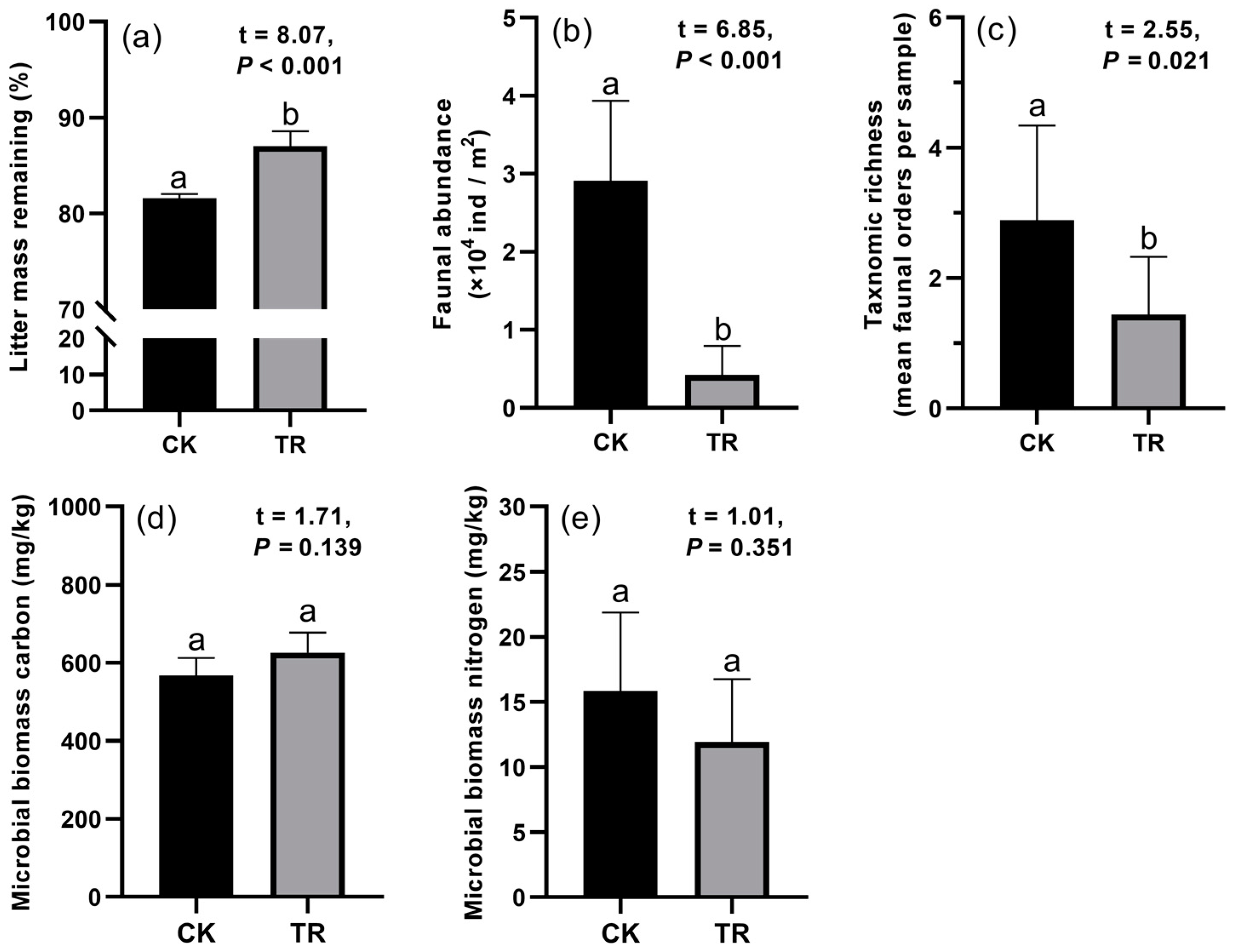
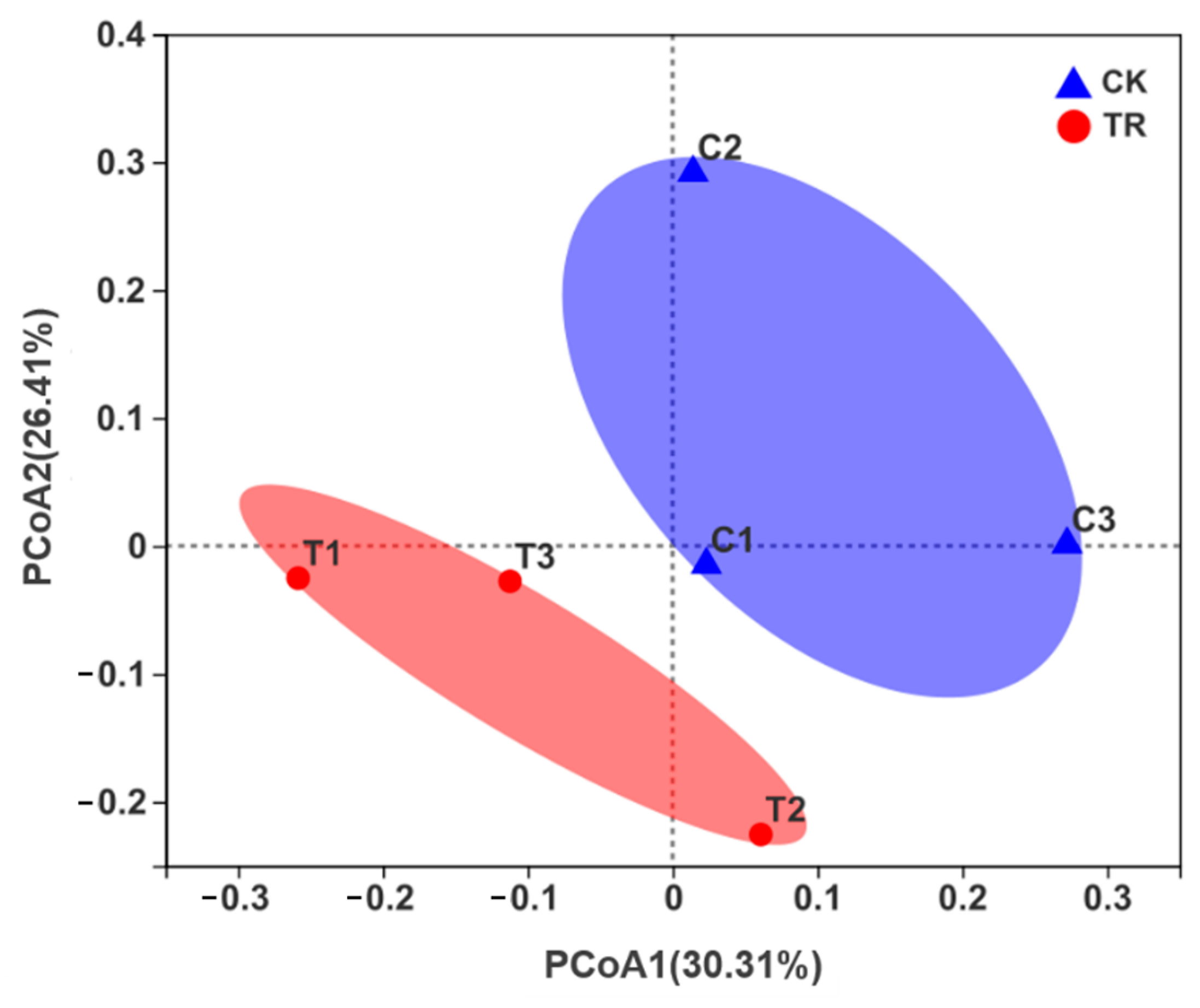
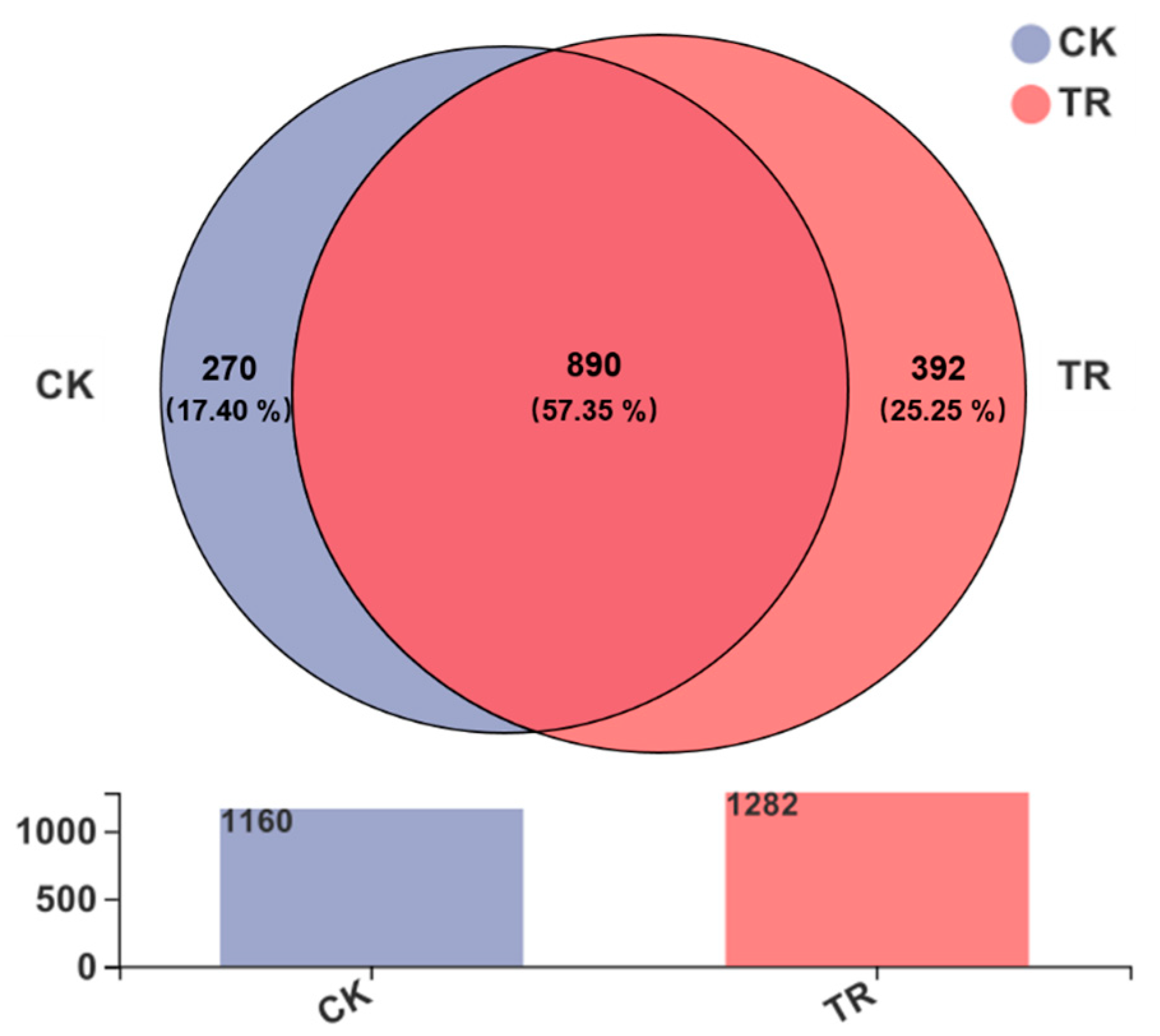
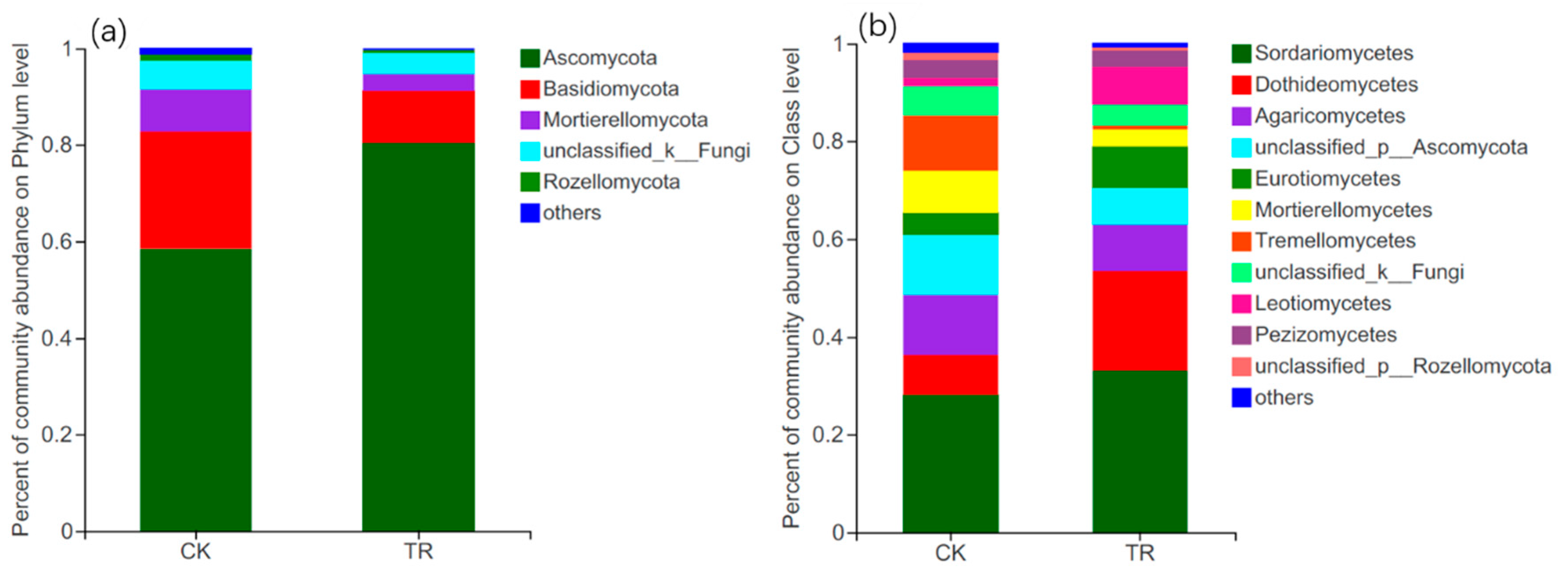
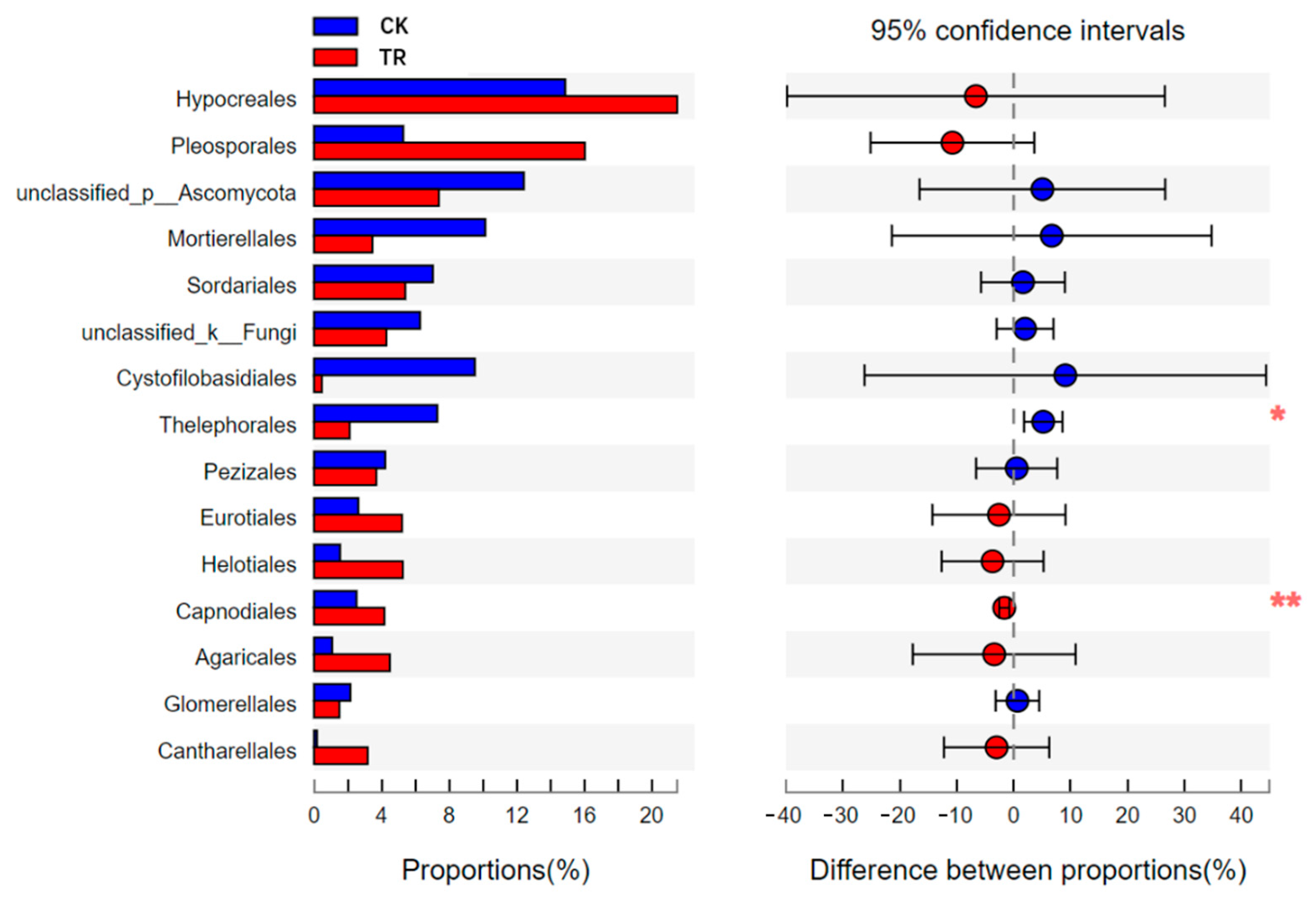
| Group | Sequence | Simpson Index | Shannon Index | Chao 1 Index | Coverage |
|---|---|---|---|---|---|
| CK | 57,293 ± 12,997 a | 0.0543 ± 0.030 a | 4.0675 ± 0.294 a | 767.45 ± 72.52 a | 99.78% |
| TR | 63,091 ± 9125 a | 0.0473 ± 0.013 a | 4.1957 ± 0.041 a | 850.18 ± 87.88 a | 99.76% |
Disclaimer/Publisher’s Note: The statements, opinions and data contained in all publications are solely those of the individual author(s) and contributor(s) and not of MDPI and/or the editor(s). MDPI and/or the editor(s) disclaim responsibility for any injury to people or property resulting from any ideas, methods, instructions or products referred to in the content. |
© 2023 by the authors. Licensee MDPI, Basel, Switzerland. This article is an open access article distributed under the terms and conditions of the Creative Commons Attribution (CC BY) license (https://creativecommons.org/licenses/by/4.0/).
Share and Cite
Xu, X.; Cao, P.; Wang, Y.; Wu, W.; Guo, J.; Sun, J.; Zou, X.; Wang, W.; Ruan, H. Effects of Naphthalene Application on Soil Fungal Community Structure in a Poplar Plantation in Northern Jiangsu, China. Appl. Sci. 2023, 13, 5794. https://doi.org/10.3390/app13095794
Xu X, Cao P, Wang Y, Wu W, Guo J, Sun J, Zou X, Wang W, Ruan H. Effects of Naphthalene Application on Soil Fungal Community Structure in a Poplar Plantation in Northern Jiangsu, China. Applied Sciences. 2023; 13(9):5794. https://doi.org/10.3390/app13095794
Chicago/Turabian StyleXu, Xuan, Penghe Cao, Yuchao Wang, Wei Wu, Jiahuan Guo, Jiejie Sun, Xiaoming Zou, Weifeng Wang, and Honghua Ruan. 2023. "Effects of Naphthalene Application on Soil Fungal Community Structure in a Poplar Plantation in Northern Jiangsu, China" Applied Sciences 13, no. 9: 5794. https://doi.org/10.3390/app13095794
APA StyleXu, X., Cao, P., Wang, Y., Wu, W., Guo, J., Sun, J., Zou, X., Wang, W., & Ruan, H. (2023). Effects of Naphthalene Application on Soil Fungal Community Structure in a Poplar Plantation in Northern Jiangsu, China. Applied Sciences, 13(9), 5794. https://doi.org/10.3390/app13095794






